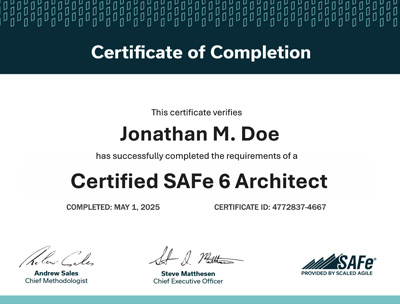SAFe Architect Certification
ARCH Training Overview
Earn the SAFe System Architect (ARCH) certification and stand out as a strategic leader.
Gain the skills to lead lean-agile transformation as a system, solution, or enterprise architect.
Learn how to align technical architecture with business value to support continuous flow across teams and systems.
Advanced Level
Already familiar with enterprise solution architects.
Course Duration
3 Days.
Instructor-led
Remote or in-person training.
ARCH Certification
Accreditation upon passing the exam.
What You Will Learn
Agile Architecture in a Lean Enterprise
Understand how architecture supports continuous value delivery in SAFe, and how to work as part of a trio of leaders guiding Agile Release Trains (ARTs).
Leading Through Change
Explore what it means to lead from a technical perspective during agile transformation, including how to develop solution vision, intent, and roadmaps.
Connecting Technical Strategy to Business Outcomes
Learn how to align architectural decisions with portfolio strategy, value streams, and enterprise goals.
Delivering at Scale
Gain practical skills to contribute to PI Planning, support DevOps and release on demand, and guide architectural runway across multiple ARTs.
Search SAFe for Architect Certification Course Dates
Who is This Certification For?
This course is ideal for senior technical professionals who want to understand the role of architects in a lean-agile organization. Whether you’re already in an architecture role or looking to expand your influence across teams and programs, this course will help you understand how architects guide agile delivery, support DevOps, and contribute to long-term business success.
System, Solution, and Enterprise Architects
Experienced Engineers
Technical Managers
Senior Technical Leaders
Infrastructure Architects
SAFe Practice Consultants

Why Choose our Scaled Agile Framework Architect Certification?
Enterprise-Level Focus:
This course shows you how to contribute architectural leadership across the enterprise – not just on one team. You’ll learn how to connect architecture to business value, support strategic themes, and coordinate across value streams and portfolios.
Flexible Delivery:
Courses are led by experienced SAFe trainers who bring practical experience in real organizations. Whether you attend virtually or in person, you’ll gain deep insights through hands-on, collaborative sessions.
Comprehensive Curriculum:
You’ll learn how to lead and align architecture with strategic themes, contribute to solution vision and roadmaps, and guide the flow of work through the continuous delivery pipeline. The course covers DevOps support, solution intent, enabler epics, non-functional requirements, and the architect’s role in PI Planning and execution.
Practical Application:
Through guided exercises and real-world examples, you’ll learn how to lead architecture initiatives during a lean-agile transformation. You’ll also build an action plan you can bring back to your organization and apply immediately.
Get SAFe Certified
Complete the course and pass the exam to become a certified SAFe Architect (ARCH). Your certification demonstrates that you have the knowledge and leadership skills to support continuous value flow, align architecture with business priorities, and help lead change at scale.
Certification Process Includes:
Perpetual access to course workbook and online learning platform for additional preparation.
An unlimited attempt practice test with question-level feedback and coaching report that acts as a simulation and study tool.
Customer support for learning and certification questions.
A timed, multiple-choice, 45-question exam with a coaching report.
Certified Professionals Earn:
Industry-leading SAFe for Architects certification, renewed yearly
Digital badge with social media share capability to grow your network.
Course certificate of completion.

SAFe Architect Certification of Completion
After attending the course, you’ll have access to the certification exam through SAFe Studio. Upon passing, you’ll receive the SAFe Architect certificate, a digital badge to show your achievement, and access to exclusive learning resources and professional development tools.
Search SAFe for Architect Certification Course Dates

Benefits of Earning your Scaled Agile Framework Architect Certification
Achieving your SAFe for Architects (ARCH) certification and keeping it active unlocks access to SAFe+ benefits like SAFe Skills and selected workshops, in addition to SAFe knowledge articles, community forums, exclusive content, and more.
Career Development & Community
Exclusive webinars on emerging SAFe topics.
Access to the SAFe community forums for career advancement, learning and mentorship opportunities, job boards, and more.
Participation in certified-exclusive events for additional networking, learning, and development.
Continued Learning
Full access to the Scaled Agile Framework.
SAFe Skills Library.
Certification upgrade learning series.
Continued learning with live and recorded webinars from SAFe experts and partners.
Access to SAFe Studio & Resources
Value stream mapping and other selected workshops.
On-demand access to all recorded keynotes, breakout sessions, and other content from SAFe Summits.
SAFe assessments to measure and improve business agility and other core competencies.
Toolkits and Applications
Access to SAFe CoPilot AI assistant.
Facilitator Guides designed to help Advanced Scrum Masters facilitate key SAFe events.
Toolkits to help prepare and execute PI Planning.
Resources for Future Solution System Architects
Learn more about our Architect certification and the latest SAFe guidance.

Getting Certified with Scaled Agile
SAFe certifications validate your skills and open new doors for career advancement. Learn how earning a SAFe® certification will expand your skills and experience, empowering you to play a key role in driving business transformation.

Agile Architecture in SAFe
Agile Architecture is a flexible, collaborative approach that evolves alongside your systems and business needs. Learn how it empowers teams to deliver value faster by balancing intentional design with rapid innovation and continuous improvement.

Enterprise Architect Role in SAFe
Learn more about how Enterprise Architects shape technology strategy, align vision with execution, and guide teams across the portfolio to build systems that are future-ready, adaptive, and aligned with organizational goals.